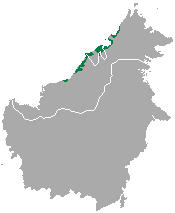Brunei Malay
| Brunei Malay | |
|---|---|
| Kedayan | |
| Bahasa Melayu Brunei | |
| Native to | Brunei, Malaysia |
| Ethnicity | Bruneian Malay, Kedayan |
Native speakers | (270,000 cited 1984–2013)[1] |
| Language codes | |
| ISO 639-3 | kxd |
| Glottolog | brun1242 |
 Area where Brunei Malay language were spoken | |
Brunei Malay (Bahasa Melayu Brunei), or Kedayan (Kadaian), sometimes conflated as Brunei-Kadaian, is the national language of Brunei and a lingua franca at some parts of East Malaysia.[2][citation needed] It is not the official language of Brunei, but it is socially dominant and currently replacing minority languages of Brunei.[citation needed] It is quite divergent from standard Malay to the point where it is almost mutually unintelligible with it.[citation needed]
Phonology
Brunei Malay has a three-vowel system, with the merger of /a/ and /ə/. Unlike its Malaysian counterpart, final <k> is an unreleased /k/ and not a glottal stop.
Dialects
Three dialects have been recognised by Bruneians, namely Brunei Malay, Kedayan and Kampong Ayer, all which sound alike. Brunei Malay is used by the numerically and politically dominant Brunei people, who traditionally lived on water. The Kedayan dialect is the one used by the land-dwelling farmers, and the Kampong Ayer dialect is used by the inhabitants of the river north of the capital.[3][4]
Common Bruneian Malay words
| Bruneian Malay | Meaning/Note |
|---|---|
| Aku | First person singular |
| Saya | |
| Peramba | First person singular when in conversation with a Royal Family Member |
| Awak | Second person singular |
| Kau | |
| Ko | |
| Awda | From '(si) awang' and '(si) dayang'. It is used like the Malaysian word 'anda'. |
| Kamu | Second person plural |
| Ia | Third person singular |
| Kitani | First person plural (inclusive) |
| Kita | To be used either like 'kitani' or 'biskita' |
| Si awang | Male third person singular |
| Si dayang | Female third person singular |
| Biskita | To address a listener of older age. Also first person plural |
| Cinta | To address a loved one |
| Ani | This |
| Atu | That |
| (Di) mana? | Where (at)? |
| Ke mana? | Where to? |
| Lelaki | Male (human) |
| Laki-laki | |
| Perempuan | Female (human) |
| Bini-bini1 | |
| Budiman | A gentleman |
| Kebawah Duli | His Majesty |
| Awu | Yes |
| Ya | |
| Inda | No |
| Tidak | |
| Kabat | To close (a door etc.) |
| Makan | To eat |
| Suka | To like |
| Cali | Funny (adj.) |
| Siuk | cf. Malaysian ‘Syok’, Singaporean ‘Shiok’ |
| Lakas | To be quick, (in a) hurry(ing) (also an interjection) |
| Karang | At a later time, soon |
| Tarus | Straight ahead; immediately |
| Manada | Used as a term when in a state denial (as in 'No way!' or 'It can't be') |
| Baiktah | 'Might as well...' |
| Orang putih | Generally refers to a white Westerner. |
| Kaling | Refers to a Bruneian of Indian descent. |
1 "Bini-bini" is exclusively used in Brunei to refer to a lady. In Malaysia and Singapore, it is an informal way to refer to one's wives or a group of married women.
Example sentences
- "Ia atu bini-bini." = She is a lady.
- "Sudah ko makan?" = Have you eaten?
- "Awda mendapat cabutan bertuah." = You have received a lucky draw.
Studies
The vocabulary of Brunei Malay has been collected and published by several western explorers in Borneo including Pigafetta in 1521, De Crespigny in 1872, Charles Hose in 1893, A. S. Haynes in 1900, Sidney H. Ray in 1913, H. B. Marshall in 1921, and G. T. MacBryan in 1922, and some Brunei Malay words are included in "A Malay-English Dictionary" by R. J. Wilkinson.[5][6][7]
References
- ^ Brunei Malay at Ethnologue (18th ed., 2015) (subscription required)
- ^ Namely, the Federal Territory of Labuan, District of Limbang and Lawas (Sarawak) and District of Sipitang, Beaufort, Kuala Penyu and Papar (Sabah).
- ^ Gallop, 2006. "Brunei Darussalam: Language Situation". In Keith Brown, ed. (2005). Encyclopedia of Language and Linguistics (2 ed.). Elsevier. ISBN 0-08-044299-4.
- ^ Wurm, Mühlhäusler, & Tryon, Atlas of languages of intercultural communication in the Pacific, Asia and the Americas, 1996:677
- ^ [1]
- ^ Uhlenbeck 1958, p. 8.
- ^ Sidhu 2009, p. 283.
Further reading
- De Crespigny, C. 1872. On Northern Borneo. Proceedings of the Royal Geographical Society XVI. 171-187. [2] [3] [4] [5] [6] [7] [8]
- Haynes, A. S. “A List of Brunei-Malay words.” JSBRAS 34 ( July 1900): 39—48. [11]
- Hose, Charles. No. 3. "A Journey up the Baram River to Mount Dulit and the Highlands of Borneo". The Geographical Journal. No. 3. VOL. I. (March, 1893)
- MacBryan, G.T. 1922. Additions to a vocabulary of Brunei-Malay. JSBRAS. 86:376-377. [12]
- Marshall, H.B. and Moulton, J.C. 1921, "A vocabulary of Brunei Malay", in Journal of the Straits Branch, Royal Asiatic Society. [13] [14] [15]
- Marshall, H.B. 1921. A vocabulary of Brunei Malay. JSBRAS. 83:45-74.
- Ray, Sidney H. 1913. The Languages of Borneo. The Sarawak Museum Journal. 1,4:1-196.
- Roth, Henry Ling. 1896. The Natives of Sarawak and British North Borneo. 2 vols. London: Truslove and Hanson. Rep. 1980. Malaysia: University of Malaya Press. [16] VOL I. [17] VOL II. VOL II. [18] [19][permanent dead link]
- http://www.jstor.org/stable/41561363?
A Vocabulary of Brunei Malay H. B. Marshall Journal of the Straits Branch of the Royal Asiatic Society No. 83 (APRIL, 1921), pp. 45–74 Published by: Malaysian Branch of the Royal Asiatic Society Stable URL: http://www.jstor.org/stable/41561363 Page Count: 30
